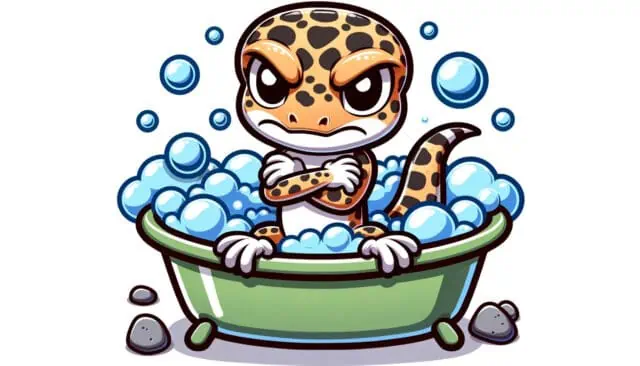Leopard Geckos can occasionally get baths, but it’s not something you should do regularly. Unless instructed by a vet or if it has difficulty shedding, it’s going to be better if you just pat it down with a wet cloth when it’s dirty. These reptiles hail from arid environments, where water sources are sparse. So, frequent immersion in water is not a natural experience for them.
Bathing Frequency: Leopard geckos don’t require frequent baths. Bathe them only when necessary, such as during problematic shedding or if they’re dirty. Young geckos under 4-5 months should be bathed sparingly.
Water Temperature: Ensure the bath water is between 85-90 degrees Fahrenheit (30-33 degrees Celsius) for the gecko’s comfort and safety.
Depth Matters: The water should be shallow, allowing the gecko to rest its belly on the bottom while keeping its head above water. This ensures safety and minimizes stress.
Risks: Avoid using loose substrate in baths to prevent ingestion, impaction, and potential skin infections. Also, be cautious of the risks of stress and potential drowning.
Natural Aversion: Leopard geckos have a natural aversion to water due to their desert origins. They have limited tolerance for water, and prolonged exposure can cause stress.
When It’s OK To Give Leopard Geckos Baths
Understanding when to give your leopard gecko a bath is vital. While these creatures are adapted to dry environments, there are specific scenarios where a bath may be beneficial.
Leopard geckos do not require regular baths. In fact, frequent bathing can be more harmful than beneficial. However, there are some situations that call for it. One of the primary reasons to give them a bath is if they have stuck or problematic shedding. In such cases, a short immersion can help loosen the shed skin.
If your gecko gets particularly dirty, a gentle bath can assist in cleaning them. Another crucial scenario is if they are experiencing constipation or prolapsed hemipenis. A warm bath can sometimes provide relief in these situations.
It’s essential to note that young leopard geckos, especially those under 4-5 months, should not be bathed. Their delicate systems can be easily shocked by the water, and the risk outweighs any potential benefit. When you do decide to bathe your gecko, ensure that the water temperature is maintained between 85 and 90 degrees Fahrenheit (30°C).
Using a thermometer can help in ensuring the right temperature. Moreover, keep the bath time short, typically around 5 minutes, to minimize stress.
Risks of Bathing Leopard Geckos
While baths can be beneficial in specific scenarios, they also come with potential risks for leopard geckos. It’s crucial to understand these risks to make informed decisions regarding their care.
One of the primary concerns is stress. Leopard geckos are not naturally inclined towards water, and immersing them can cause significant anxiety. This stress not only affects their mood but can also impact their overall health. Another significant risk is drowning. Even though the recommended depth for a bath is shallow, there’s still a chance, especially for seriously ill geckos, to drown if they are unable to keep their heads above the water.
Furthermore, if your gecko has wounds or open sores, bathing can lead to infections. Keeping wounds wet can lead to slow healing, creating an environment conducive to bacterial or fungal growth. And speaking of infections, frequent baths can disrupt the natural balance of bacteria on your gecko’s skin. This imbalance can make them more susceptible to bacterial or fungal infections, which can be challenging to treat.
Lastly, seriously ill geckos are at a higher risk. Their weakened state can make it harder for them to handle the stress of a bath, and they might be more susceptible to the risks of drowning or infections.
Setting Up a Bath for Your Leopard Gecko
Properly setting up a bath for your leopard gecko is crucial to ensure their safety and comfort. While the process might seem straightforward, there are specific details and considerations to keep in mind. The water’s temperature, depth, and the substrate used can all impact the effectiveness and safety of the bath.
Temperature of the Water
The water temperature is a pivotal aspect when setting up a bath for leopard geckos. Maintaining a range of 85-90 degrees Fahrenheit (30-33 degrees Celsius) is essential. This specific range ensures the gecko’s comfort and helps in avoiding potential stress or harm.
Remember, leopard geckos are reptiles. Unlike humans, they rely on the surrounding environment to regulate their body temperatures. A sudden change, especially to a temperature outside their comfort zone, can be detrimental to their health.
It’s not just about setting the right temperature initially; it’s also about maintaining it. Using a thermometer is crucial to monitor the water’s temperature consistently.
Depth of the Water
The depth of the water is another vital component to consider when preparing a bath for your leopard gecko. The recommended depth is such that the gecko should be able to comfortably rest its belly on the bottom of the container while easily keeping its head above water. This depth ensures that they feel secure and can breathe without any obstruction.
Too deep water presents several risks. Primarily, there’s the risk of drowning. Even if a gecko seems comfortable, deeper water can quickly become a threat, especially if the gecko becomes stressed or panicked. Additionally, excessive water depth can cause undue stress to the gecko, as they might struggle to keep their head above the surface or find a comfortable position.
Risks of Using Loose Substrate in Baths
Using loose substrate in leopard gecko baths might seem like a harmless choice, but it introduces a host of potential risks. Substrates, such as sand or small gravel, can cause several issues if used during bath time.
Firstly, there’s the risk of ingestion. Leopard geckos might accidentally swallow bits of the substrate, especially if they attempt to drink the bathwater. Over time, this can lead to impaction, a blockage in the digestive tract that can be life-threatening if not treated.
Additionally, small particles from the substrate can stick to the gecko’s wet skin. Once dried, these particles can cause irritation, leading to potential skin infections. These infections can be painful for the gecko and might require medical intervention.
How Often Should A Leopard Gecko Get a Bath?
Determining the frequency of baths for your leopard gecko hinges on several factors related to its health and age. It’s crucial to note that these reptiles don’t require frequent baths like some other pets.
Shedding is a natural process for leopard geckos. During this time, a bath might help, especially if the gecko has stuck-on shed that isn’t coming off easily. Bathing can moisten the skin, making it simpler for the gecko to shed completely.
Clogged femoral pores are another reason for a bath. These pores, found on the underside of the gecko, can sometimes become blocked. A warm bath can assist in loosening the blockage, aiding the gecko in clearing the pores.
If your gecko shows signs of mild constipation, a bath can also be beneficial. The warm water can stimulate bowel movements, offering relief to the gecko.
However, frequent bathing can be stressful for leopard geckos and might not always be necessary. It’s generally advised to bathe your gecko once a month or less, depending on the situations mentioned above. Always consider the age of the gecko when deciding on a bath. Younger geckos, especially those under 4-5 months, should be bathed sparingly.
Do Leopard Geckos Like Getting Wet?
Leopard geckos, by nature, have an aversion to water. This trait is deeply rooted in their biology and the conditions of their natural environment. Originating from arid areas and deserts, these reptiles have evolved in environments where water is sparse. Their bodies and behaviors have adapted to these dry conditions, making prolonged exposure to water foreign and uncomfortable for them.
Their limited tolerance for water means that while they can handle occasional moisture or a brief bath, they generally don’t enjoy being wet. When placed in water or a damp environment, leopard geckos can become anxious. This discomfort is not merely a matter of preference but a reflection of their evolutionary history.
Furthermore, immersing a leopard gecko in water or keeping them wet for extended periods can cause potential stress. Stress in reptiles, just like in other animals, can lead to various health issues and a decreased lifespan.
PS: if you enjoyed this article, check out some of the others and learn more about the eyes of leopard geckos and how to care for them.






